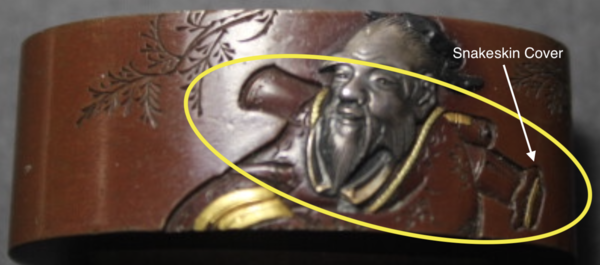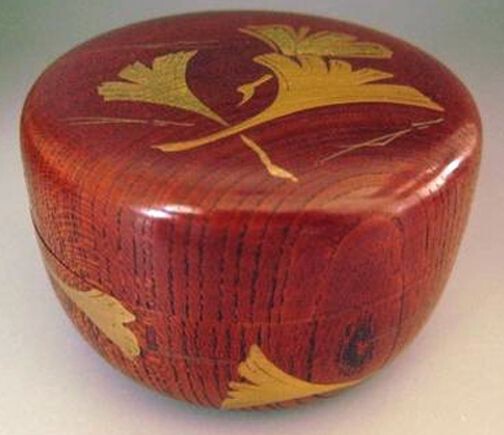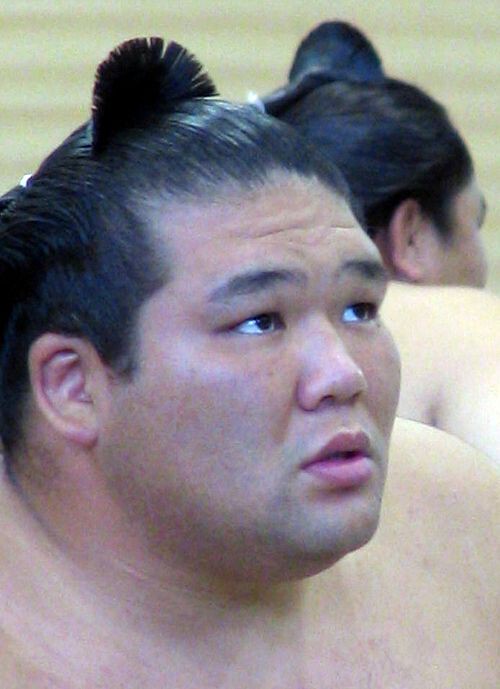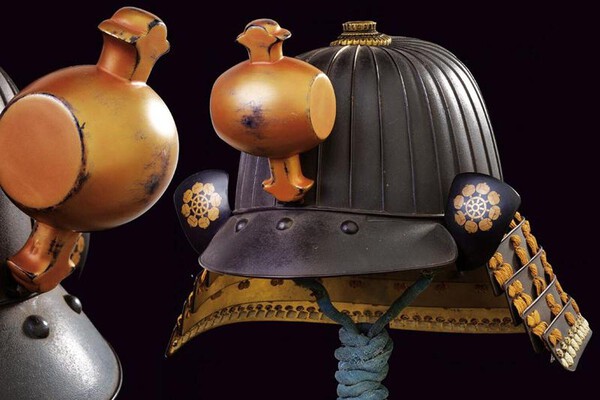-
Posts
858 -
Joined
-
Last visited
-
Days Won
7
Everything posted by Tanto54
-
Brian are you thinking about Kyo-Goto? They use that gourd and vine design.
-
Dear Bob, it is very refreshing to hear your honest opinion about “bones” in your various posts above. Too often I hear something like “experienced collectors should only collect old iron” or “no self-respecting Samurai Warrior would have a kinko (soft metal) tsuba.” I don’t know why (perhaps it is for the reasons that you indicated in your post above), but it seems that some of the Iron Guys feel the need to bully everyone into their way of thinking. Personally, I like both iron and kinko, and I believe that people should collect what they like (but they just shouldn’t be bullied or misled into it and they shouldn’t bully others). I also often hear “my Sword Sensei told me that real Samurai Warriors only used iron tsuba”. I want to respond, “was that the Sensei that told you to sweep the leg?” As Daniel learned, sometimes the Sensei is wrong... Occasionally, people need to study and think for themselves instead of relying on the often repeated BS. The idea that true Samurai Warriors only liked somber old iron is simply not true. In fact, the whole wabisabi somber, old iron aesthetic came from non-Samurai and non-Warriors like Sen no Rikyū, the famous tea master. He was a merchant and fishmonger. Later he was made a Buddhist priest, but he was never a Samurai or Warrior. The “ami” who regulated the import of Chinese art, literature and ideas (in the early times when the Samurai were coming to power in Japan) were not Samurai or Warriors either, but they governed the aesthetic including official tosogu and koshirae and tea ceremonies for mid and upper Samurai. The Shogun used these “art advisors” to help govern and control the Daimyo and Samurai under them by requiring the Samurai to expend great resources on old iron tsuba, tea bowls, etc. This was very much like the sankin-kōtai system (alternate residence system), which the Shogun used to keep the Daimyos under control. That system required them to spend a great deal of money to travel and change residences every other year (keeping them too poor to raise an army against the Shogun....) The bottom line is that true Samurai Warriors liked and used both iron and kinko tsuba, and irony is that the somber, old iron tsuba aesthetic came from merchants, tea masters and art advisors not Samurai or Warriors... As an aside, I have a Japanese friend in Tokyo who loves trains. He and his buddies get together once a quarter to talk about them. He tells me that one of the greatest possessions that members of his club have is a used iron electrical contact from the top of an electric subway car that is worn down from riding against the electrical supply cable. It’s basically a long iron bar with smooth groves in it. He says that members can talk for hours about those wear marks and almost get aroused when running their hands over the worn groves on that iron electrical contact.... That’s what I think about when I hear people going on and on about tekkotsu (bones) on tsuba...
-
Hi Bob, Love the shibuichi patina and silver "crystals" in it on your Tsuba #13. The bird is a cuckoo (hototogisu) and is commonly paired with the moon in Japanese art. It is the harbinger of Summer and its call is sometimes interpreted as an omen of calling good souls to heaven.
-

Thoughts on restoration of nihonto fittings
Tanto54 replied to mgraffam's topic in General Nihonto Related Discussion
Hi Michael, my opinion (for whatever it's worth...) is that this is not original and is not a Japanese wrap. I base this opinion on several factors, including that the fabric is too clean.... I have seen many authentic fabric wrapped tsuka, but anything older than 20 years or so would always show dust and dirt in the crevasses. Your's is too pristine. In addition, the ito and menuki placement look like a recent Western job. The rest of the tosogu is "put together" and not a harmonious whole. As you said in one of your earlier posts, I think those aspects are a "dead giveaway", and therefore, if it were mine, I'd redo it to appear more authentic... -
Thanks Jussi - Herculean effort!!! Thanks for sharing.
-
Dear Bob, Thanks for the recurring "eye candy".... Each day when I check NMB, I'm looking forward to another of your beautiful tosogu! Please keep it up.
-
Dear Bob, There are 20 artist entries in Haynes for Masakatsu signing with your kanji. Haynes 04085.0 is one of them, but he is from Karatsu, Sakura and Odawara. Haynes 04087.0 (who also signs with your kanji) is the only one listed from Bushu, so I think he is your guy. He worked in the 1800's, and his style and mei matches your tsuba (and he is probably the one you are looking at in Sesko).
-
Dear Bob, Your No. 8b (Masayoshi Fuchigashira) was really a tough one. Tekka Sennin was a good guess because if Gama Sennin is combined with another Sennin on tosogu, 99.9% of the time it is Tekka Sennin. In this very rare case, the other Sennin on your fuchi is Chokaro (sometimes Chokwaro) Sennin. What made it so difficult is that Chokaro Sennin is almost always shown with his main attribute - a white horse/mule coming out of a gourd. In the case of your fuchigashira, Chokaro Sennin has a yuku or fish drum over his shoulder. A fish drum is a musical instrument formed from a bamboo tube with one end covered by snakeskin (see the snakeskin cover held on by some gold cord at the bottom right of the photo of your fuchi below?). Chokaro Sennin is based on the Chinese Immortal Zhang Guo Lao, and in classical Chinese Art, Zhang Guo Lao (Chokaro Sennin) is usually shown with a yuku (fish drum) even though he can also conjure a horse/mule from a gourd. One of the disciplines of elite Samurai was the study of classic Chinese Art and Literature, so your fuchigashira is a Samurai "flexing" that knowledge. Is there anything on the other side of the fuchi? Woodcut of Zhang Guo Lao (Chokaro Sennin):
-
Howard Hughes' Spruce Goose....
-
Dear Chuck, sorry your tsuba is a modern fake - a cast tsuba. You can tell this by how the mei has a pressed in (instead of carved) look and the way the other details have been smoothed over in the finishing process (along with molding lines in the sukashi and casting investment remaining in the crevices). I think that Grey is making a joke about Barry's accidental misspelling of cast as "caste".
-
Dear Antonis, Most tsuba that have this "Chinese Landscape" scene with a Chinese Sage (with or without an attendant) on a path with a temple/pagoda partially hidden in the mountains are references to Mount Hōrai (Mount Penglai). Mount Hōrai is a legendary, holy Chinese mountain in the Eastern Sea that is often visited by hermits and is the base for the Eight Immortals. Legend has it that the Chinese Emperor sent Jofuku (Chinese Xu Fu) to find the elixir of Immortal Life on Mount Penglai, and he found Japan instead deciding that Mount Fuji was Mount Penglai. Looking at your tsuba, it has a Chinese Scholar with an attendant, sharp mountains with a partially hidden pagoda, a mountain that looks like Mount Fuji hovering above in the clouds and a large lake with boats in front of the mountain that looks like Lake Biwa (famous lake next to Mt. Fuji). Therefore, I think your tsuba shows Jofuku and Mt. Fuji as Mount Penglai. I’ve attached a painting entitled Mount Penglai that closely resembles your tsuba.
-
Dear Artur, As you may know, Haynes says the following about Shozui (Hamano Masayuki): "The majority of the signed examples seen today are forgeries, particularly the tsuba". While I don't agree with the often repeated line that most swords or tosogu are gemei, I'm afraid that I have to agree with Curran here. I looked at many of his published mei and they do not match your tsuba. Perhaps more importantly, the style of the artwork and the quality of the katakiribori do not match his work either (remember, he was considered the next greatest after the Nara Sansaku... the three greatest masters of that time). If you look carefully, you will see many errors and hesitation in the katakiribori carving. Having said that it is still a genuine tsuba that I'd be happy to own.
-
Dear Barrie and Bob, To answer Bob's question about why the Shinsa Team said it was Naokatsu "but not Inagawa": I think it is because Inagawa Naokatsu is probably the best known of this group of Naokatsu, and they wanted to clarify that it was not him. I think that the Shinsa Team could say that definitively because [I think] they use Wakayama's Toso Kodogu Meiji Taikei for some mei confirmations and it has eight samples of that Naokatsu's mei and it doesn't appear to match Bob's tsuba. Like I mentioned before, Hanyes lists 6 Naokatsu that sign using the characters on Bob's tsuba. In my previous post, I explained why I thought 4 of them were not the maker of Bob's tsuba. That left 2 possibilities, and after looking at the materials that Barrie kindly provided, I agree that it is probably not Joly 104 either. That removes the 5th possibility, leaving only Hamano Naokatsu as the possible maker. As mentioned before and as a double check, someone should compare Bob's tsuba to a known sample of Hamano Naokatsu's mei and kao. Haynes says there is a sample of his mei in another Wakayama book - Toso Kinko Jiten (475-L-4). Because I don't have the other Wakayama book with that sample, I did look up Hamano Naokatsu's teacher (Hamano Naoyuki) in my other Wakayama books. I found that Naoyuki (Noakatsu's teacher) used a kao that is almost identical to the one on Bob's tsuba. Therefore, because students often use a kao like their teacher, I am even more convinced that Bob's tsuba was made by Hamano Naokatsu.
-
Dear Bob, For your second tsuba (Chokaro Sennin), I believe that Inagawa Naokatsu and Yanagawa Naokatsu are the same person, and he almost always signed with a 4 character mei + kao (starting with either Inagawa or Yanagawa). He uses a lot of different kao including a "Yokoya" style kao (not saying he is from the Yokoya School - just that some of his kao are of that style). Your tsuba has a "Yokoya" style kao too, but while the kao on your tsuba comes close to a few of Inagawa/Yanagawa Naokatsu's kao, the mei does not match. Therefore, I think that you can rule out Inagawa/Yanagawa Naokatsu. The other option that you mentioned, Hamano Naokatsu is fairly rare and the only reference to a sample of his work is in Wakayama's Toso Kinko Jiten W-475-L-4 (which I can't reference at the moment). Perhaps someone else who has that book can check the mei and kao for you. Haynes lists 4 other Naokatsu that sign with your kanji, but one of them usually follows his mei with "saku" and another uses a completely different kao (so it wouldn't be those two). One of them uses a similar kao and can be found in Joly's Shosankenshu n-104 (which I also do not have access to at this time - perhaps someone can check this too). Based on the three options that you gave, I'd go with Hamano Naokatsu (just have someone confirm the mei in Wakayama).
-
Hi Bob, Sorry if I was unclear - only the signature is shown in Sesko's Signatures of Japanese Sword Fittings Artists, but I can tell from the mei and the sekigane that it is your tsuba (on the far right below - hopefully the quality of my scan is good enough for you to see it too). I've also included the entry for your maker from Haynes' The Index of Japanese Sword Fittings and Associated Artists.
-
Dear David, I am happy that I could help. Just to be clear, I think that kanagu are wonderful things and many are very highly regarded by collectors (at the same level as menuki). Just like menuki, there are good ones and bad ones. Many famous tosogu makers also made kanagu (like Natsuo). So in my opinion, nothing wrong with them being tobacco pouch fittings.
-
Dear David, You said that you think that your items are too small to be the decorative outer piece of a tobacco pouch. However, those decorative tobacco fittings come in many sizes, including those that are smaller than standard menuki (see photo below). The photo of the backside and the plates of your four items confirm 100% that these were kanagu (fittings or snaps) for tobacco or money pouches. Unfortunately, the photo of the backs that you provided is at an angle that does not let me tell you whether any of them are converted from menuki (I need to see a "straight on" photo of the backs). I've attached a photo of one of the things that I would look for below. The black oval shows were the single rectangular menuki pin was and the two yellow rectangles show where the later two kanagu (tobacco pouch ornament) pins were, so the one pictured below was originally a menuki and was later adapted to be a tobacco pouch pin (and then later someone removed the tobacco pouch pins).
-
Dear Bob, Lovely Tsuba. As you may know, Masatsugu worked in the late 1700’s in Kyoto and the surrounding area (including at Fushimi - the famous Inari Shrine in Kyoto). Your Masatsugu is Haynes H04701.0 and matches the mei and kao in several books (including Sesko’s Signatures of Japanese Sword Fittings Artists - but it should match because it’s your Tsuba on the bottom right of page 227 - right?). In the late 1700’s in Japan, Ginkgo Leaves could have symbolized several different things: Fall, endurance, longevity or the Urasenke School of Tea Ceremony (it is their emblem). In the case of falling ginkgo leaves like those on your tsuba, endurance and longevity are not likely themes. While Fall is a possible motif, I believe that your tsuba was probably made for a Samurai who was a member of the Urasenke School of Tea Ceremony. I reach that conclusion because Masatsugu worked in and around Kyoto (near the headquarters of the Urasenke School), and because I have seen several tea ceremony articles related to Sekiō Sōshitsu (who was the 9th Master of Urasenke during the time your tsuba was made) with this kind of falling ginkgo leaves design (and this is the emblem of the Urasenke School). I love your idea for this thread and am looking forward to seeing more of your collection. The following are a couple of photos of tea utensils with falling ginkgo leaves (not necessarily related to Urasenke or Sekiō Sōshitsu) (by the way, one of the Sumo hairstyles is a Chonmage that symbolizes a ginkgo leaf, but I don't think your tsuba symbolizes tumbling Sumo Players...)
-
Hi David, As Michael said, these are tobacco pouch ornaments and the back plate is the "snap" that keeps the tobacco pouch cover closed. The ornament is attached to the back plate through the leather/fabric flap via the two thin wire posts, that's why the plate can be bigger than the ornament (because it is hidden behind the leather/fabric flap). These ornaments are sometimes converted menuki, but we would need to see the backs of yours to know for sure (but based on the looks of the fronts, most of yours were probably not ever menuki).
-

Darcy's current tosogu listings
Tanto54 replied to Brian's topic in Auctions and Online Sales or Sellers
Thanks for the reminder Brian Darcy has fantastic tosogu that is rarely seen outside of DTI and high-level Japanese collections. Michael, your fuchigashira is breathtaking - truly amazing how they can convey so much in such a tiny space - the birds' postures and expressions are masterful true art. -
Thomas, in fairness, your main point was not anything about the birth year - it was all about Paul's habaki must be from a Merchant sword because a Samurai would not own something related to wealth. To your credit, you have now admit that was incorrect. Attempting to pivot your "main point" is not to your credit... Like I said, it is fairly clear that you won't change your mind no matter how much evidence is presented, so I won't waste too much time presenting it. I'll just point out that you can find many ensuite tosogu from before 1868 that have all chickens (or oxen, or dogs, or any other of the 12 Zodiac animals). Why would a Samurai put all chickens on his sword? Was he a chicken farmer in his part time? Did he just really like chickens? No, he did it because it was his Zodiac sign. I've studied this and am sure of my position - have you? If not, I encourage you to do a little research so you can be fair in your responses.
-
Dear Thomas, I think that you yourself have admitted that your point is incorrect. If you will forgive me - as we say in the Dojo, you need to use your head for something more than just something to strap your Men to (Men = Kendo head protector). You admitted that the wealth “symbols of Daikoku were used on Samurai goods”, but then you say that Paul’s habaki must be from a Merchant’s sword because it has a wealth symbol of Daikoku on it... Very faulty circular logic. It looks like you’ve made up your mind and no amount of evidence will cause you to change it, so usually I wouldn’t respond. However, this is one of those myths and stereotypes that is detrimental our Nihonto hobby, so I will respond for the sake of others. The idea that Samurai shunned wealth is largely a romantic myth (see modern scholarly critiques of the famous Bushido Code book). That stereotype is detrimental to our hobby because it causes many members to ignore or shun perfectly good swords and fittings that were owned by authentic Samurai because they have been told that "those are just merchant swords or fittings”. Your prejudice against symbols of wealth on swords is simply a Western romanticization that could have the effect of diminishing the value or apparent “worthiness” of Paul’s habaki. Furthermore, Japanese do not have a negative view of rats like Westerners do. Whenever possible, I try to correct these old myths/prejudices for the sake of our hobby. Finally, you say that just because you haven’t seen many Samurai goods with sheep on them proves that Japanese did not use their birth Zodiac animals on their goods. The idea that Japanese did not use their birth animals on things like swords, netsuke, tobacco pouches, etc. is simply wrong. Ask anyone who knows about Japanese culture and they will set you straight on this point. In fact, you will find Samurai and Merchant articles with sheep (and rams and goats - they are used interchangeably) in Japan. The reason that you probably haven’t seen very many is because the Westerners who visited Japan in the late 1800’s & early 1900’s and who brought back most of the swords and fittings that you see today had the same prejudices against sheep (and rats) that you have. So they didn’t bring those back for you to see (they mainly just bought the "cool ones" with dragons or tigers...) Coming back to your main point - that Samurai shun wealth. That is like saying Knights went around doing only good deeds and protecting Maidens’ honor (a very nice romantic notion but disproved by scholarly research....) Take a look at the daisho below from the 1600’s wrapped in Gold - clearly owned by Samurai and clearly not shunning wealth. Look at most Tachi koshirae - only owned by Samurai - very wealthy and flashy. Of course there are exceptions and schools who followed the tea masters wabi sabi and iron tsuba only rules (but remember that the tea masters were themselves, ironically, more related to Merchants than Samurai....). However, those are minor exceptions and no where near the majority. Finally, the new photos provided by Paul above (that shows that the habaki is much smaller than a normal wakazashi habaki) indicate that the habaki is from a tanto. That means that Paul's habaki is most probably a presentation tanto for a new Samurai baby born in the Year of the Rat. Because such presentation tanto are a Samurai tradition, this makes it even more likely that it belonged to a Samurai instead of a Merchant.
-
Sorry Thomas, you are incorrect. There are many verified samurai articles with rats on them. Your anti-commercial view is quite romantic (but inaccurate...). The fact is that we don't see many decorated habaki at all (meaning with figures not just cross hatching, cat scratching, etc.) - that's why you don't see many chickens, sheep, cows, snakes, etc. on them... What do you think happens to the 1/12 of Samurai that were born in the year of the Rat? Were they forced to become merchants? As you say, rats are sometimes the "harbinger of material wealth", but that is only sometimes the case and when it is, it is because of their association with the Japanese Gold of Wealth Daikoku. While a rat is one of Daikoku's secondary attributes, his main attribute is A Golden Mallet called Uchide no Kozuchi - otherwise known as the "mallet of fortune”. You can find many swords and tosogu decorated with Daikoku (and his attributes: the Mallet, a Rat or a Bale of Rice), but I imagine that you would say all of those are merchant swords. However, you will find all of those attributes on Katana and Daisho which should be reserved for Samurai. Surely you've seen some of the great Daikoku horimono on swords that were owned by Samurai. Putting the God of Wealth or his attributes (the mallet or rats) on Samurai only articles debunks your assertion that Samurai wouldn't aspire to wealth. That's more of a Western romantic interpretation (how do you think they paid for their Wars???) Finally, surely you've seen kabuto with old maedate in the shape of a golden hammer (I've seen at least 50 over the years from various periods) - well, merchants didn't wear helmets did they... These are clearly recognized as Uchide no Kozuchi the Golden Mallet symbolizing Daikoku the God of Wealth (and they are on Samurai helmets....).
-
The Japanese follow a 12 year repeating Zodiac with one of the years being the year of the Rat. As such, approximately 1/12 of Japanese are born in the year of the Rat. Many years ago, they believed that your Zodiac animal affected your behavior and fate and actually made important decisions (e.g., marriage, promotion, etc.) based on your animal sign. Japanese from all classes and vocations followed these traditions. Therefore, it is just as likely that a Samurai carried a sword with a rat on it as a merchant.
























